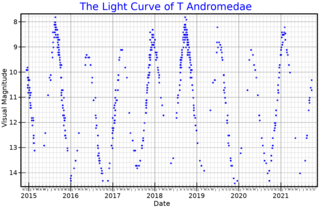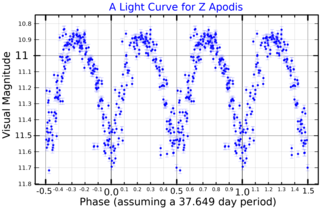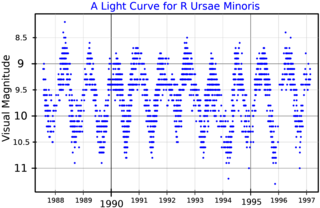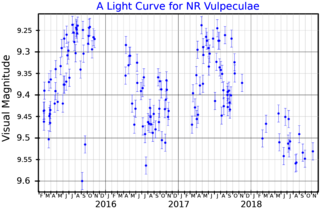
R Horologii is a red giant star approximately 760 light-years away in the southern constellation of Horologium. It is a Mira variable with a period of 404.83 days, ranging from apparent magnitude 4.7 to 14.3—one of the largest ranges in brightness known of stars in the night sky visible to the unaided eye. The star is losing mass at the rate of 5.9×10−7 M☉·y−1.

R Virginis is a Mira variable in the constellation Virgo. Located approximately 530 parsecs (1,700 ly) distant, it varies between magnitudes 6.1 and 12.1 over a period of approximately 146 days. Its variable nature was discovered by Karl Ludwig Harding in 1809.

T Andromedae is a variable star of the Mira type in the constellation Andromeda. Like all the stars of this kind, T And is a cool asymptotic giant branch star of spectral type M4e-M7.5e. Its brightness varies periodically, completing a cycle in 281 days. The peak luminosity, however, is different every variability cycle, but can reach a peak magnitude mv=7.70.

Z Apodis (Z Aps) is a variable star in the constellation of Apus. It has an apparent visual magnitude which varies between 10.8 and 12.8, over a period of 39.37 days. Although described in the General Catalogue of Variable Stars as a cataclysmic variable star, it appears that it is a pulsating variable star, and has been classed as an RV Tauri variable star, type RVa. Other sources classify it is a type II Cepheid.

R Reticuli, also listed under the duplicate variable star designation S Reticuli, is a Mira variable star in the southern constellation Reticulum. It is an aging red giant star on the asymptotic giant branch with a stellar classification that varies between M4e to M7.5e, being hottest near maximum visual magnitude. The brightness of the star varies between apparent visual magnitudes 6.35 and 14.2 with an average period of 281.08±0.58 d. The mean maximum magnitude is 7.57 and the mean minimum magnitude 13.80.

HD 183144 is a suspected variable star in the equatorial constellation of Aquila. It is a hot giant star about 1,130 light years away.
HD 156768 is a double star in the southern constellation of Ara, with a combined apparent magnitude of 5.86. The brighter component is a sixth magnitude bright giant or supergiant star with a stellar classification of G8Ib/II. The magnitude 9.6 companion lies at an angular separation of 1.81″ along a position angle of 184°.
HD 118508 is a suspected variable star in the northern constellation of Boötes. Its apparent magnitude may vary with an amplitude of 0.04, discovered during a search for small-amplitude red variables. It is a red giant about 552 light years away.

HD 135530 is a suspected variable star in the northern constellation of Boötes.

R Boötis is a variable star in the northern constellation of Boötes. The star's brightness varies tremendously, ranging from apparent magnitude 6.0, when it might be faintly visible to the naked eye under very good observing conditions, to 13.3, when a fairly large telescope would be required to see it. The distance to this star is approximately 2,150 light years based on parallax measurements. It is drifting closer with a radial velocity of about −58 km/s.

W Andromedae is a variable star in the constellation of Andromeda. It is classified as a Mira variable and S-type star, and varies from an apparent visual magnitude of 14.6 at minimum brightness to a magnitude of 6.7 at maximum brightness, with a period of approximately 397.3 days.

Zeta Chamaeleontis, Latinized from ζ Chamaeleontis, is a star located in the constellation Chamaeleon. It is a 5th magnitude star, faintly visible to the naked eye under good observing conditions. Located around 540 light-years distant, it shines with a luminosity approximately 522 times that of the Sun and has a surface temperature of 15,655 K.

R Equulei is a class M Mira variable star in the constellation Equuleus. Its brightness varies between a minimum magnitude of 15.0 to a maximum of 8.7 with an average period of 261 days.

Eta Piscis Austrini is binary star system in the southern constellation of Piscis Austrinus. As of 2000, the two components had an angular separation of 1.818 arc seconds along a position angle of 113.4°. The pair have a combined apparent visual magnitude of +5.43, which is bright enough to be seen with the naked eye. Based upon an annual parallax shift of 3.99 mas as seen from the Earth, the system is located roughly 820 light years from the Sun.

S Canis Minoris is a variable star in the equatorial constellation Canis Minor. It has a peak apparent visual magnitude of 6.5, so not normally visible to the naked eye. The star is located at a distance of approximately 1,340 light-years from the Sun based on stellar parallax, and is drifting further away with a radial velocity of about +68 km/s.
ι2 Muscae, Latinised as Iota2 Muscae, is a blue-white-hued star in the southern constellation Musca, near the constellation's southern border with Chamaeleon. It has an apparent visual magnitude of 6.62, which is just below the normal limit of stellar brightness visible to the naked eye. Based upon parallax measurements, it is located around 492 light-years from the Sun. It is a member of the Hyades Stream, but is not part of the Hyades or Praesepe open clusters.

R Ursae Minoris is a star in the constellation Ursa Minor. A red giant of spectral type M7IIIe, it is a semiregular variable ranging from magnitude 8.5 to 11.5 over a period of 325 days.

R Cancri is a Mira variable in the constellation Cancer. Located approximately 250 parsecs (830 ly) distant, it varies between magnitudes 6.07 and 12.3 over a period of approximately 357 days. At its brightest, it is very faintly visible to the naked eye.

BI Cygni(BI Cyg, IRC +40408, BD+36 4025) is a red supergiant in the constellation Cygnus. It is an irregular variable star with a maximum brightness of magnitude 8.4 and a minimum of magnitude 9.9. It is considered a member of the Cygnus OB1 stellar association, its distance is around 1,300 parsecs (4,200 ly) of the Solar System. It is less than a degree south of another variable red supergiant, BC Cygni.

NR Vulpeculae is a red supergiant and irregular variable star in the constellation Vulpecula. It has an apparent magnitude varying between 9.13 and 9.61, which is too faint to be seen to the naked eye.

















